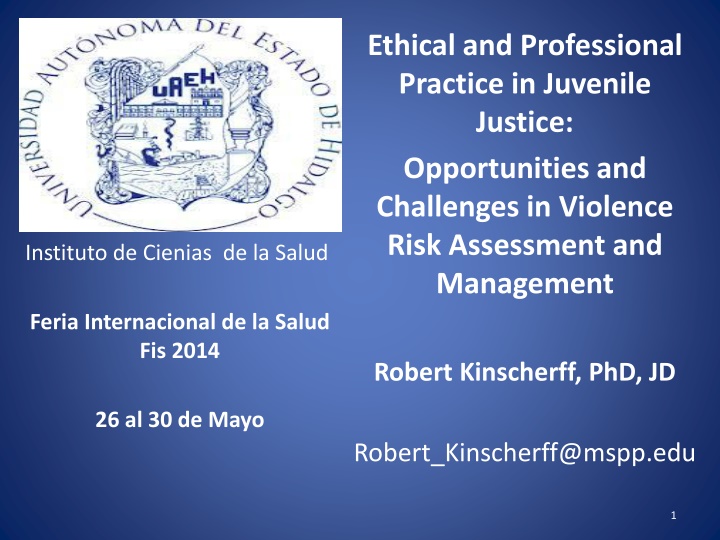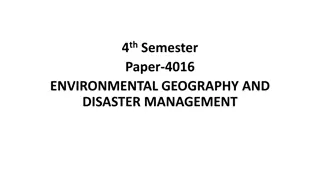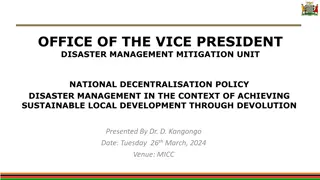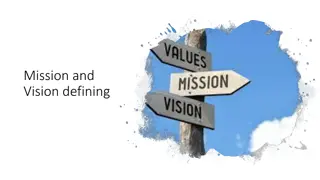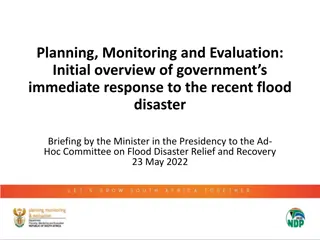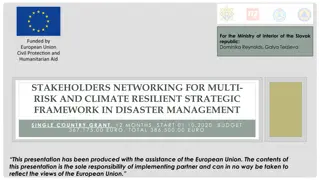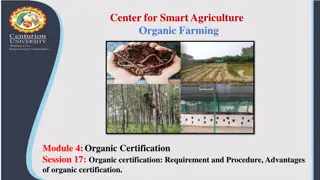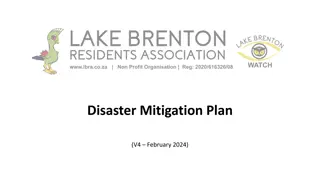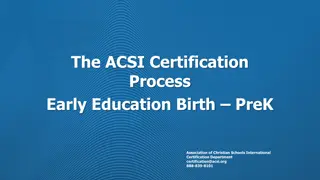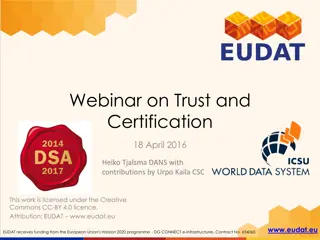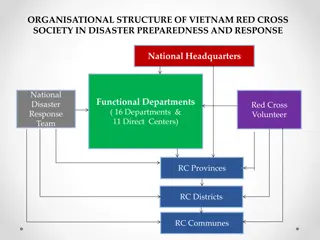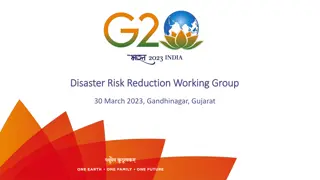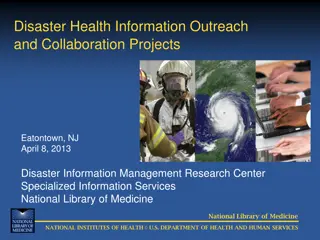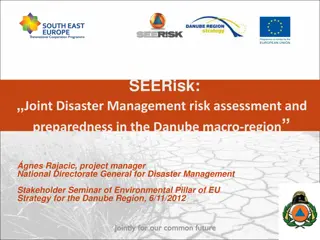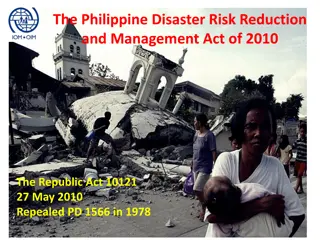Professional Certification Agency for Disaster Management: Vision and Mission
Professional Certification Agency for Disaster Management (PCA-DM) was established to assess and certify the competence of humanitarian workers and volunteers in disaster management. Their vision is to provide competent human resources with high integrity, while their mission includes developing professional competency standards and certification schemes. PCA-DM collaborates with various agencies and organizations to build capacity in disaster management and conducts competence tests to ensure quality services. They aim to fulfill global competition standards and enhance disaster response capabilities through certification programs.
Download Presentation

Please find below an Image/Link to download the presentation.
The content on the website is provided AS IS for your information and personal use only. It may not be sold, licensed, or shared on other websites without obtaining consent from the author.If you encounter any issues during the download, it is possible that the publisher has removed the file from their server.
You are allowed to download the files provided on this website for personal or commercial use, subject to the condition that they are used lawfully. All files are the property of their respective owners.
The content on the website is provided AS IS for your information and personal use only. It may not be sold, licensed, or shared on other websites without obtaining consent from the author.
E N D
Presentation Transcript
Ethical and Professional Practice in Juvenile Justice: Opportunities and Challenges in Violence Risk Assessment and Management Instituto de Cienias de la Salud Feria Internacional de la Salud Fis 2014 Robert Kinscherff, PhD, JD 26 al 30 de Mayo Robert_Kinscherff@mspp.edu 1
A Surprising Beginning? I am going to speak about what may the most important thing that has ever happened in human history. Violence has declined by dramatic degrees all over the world in many spheres of behavior: genocide, war, human sacrifice, torture, slavery, and the treatment of racial minorities, women, children, and animals. Dr. Steven Pinker, Harvard University The Better Angels of Our Nature, How Violence Has Declined (2011) 2
Integrating Perspectives Violence as a Public Health challenge Socioeconomic factors Poverty, education, access to health care, other Social context factors Community engagement, family/peers, social attitudes Long-lasting Protective interventions Maternal health, early childhood wellness, other Clinical interventions Evidence-based interventions with delinquent youth 3
Integrating Perspectives Violence a challenge to Professional Ethics The social obligations of recognized professions Professionals working within strained systems Professionals working within toxic systems Ethical duties to be based in science, best practice Ethical duties to do no harm, minimize harm 4
Integrating Perspectives Violence a challenge to Clinical Practice in: Primary prevention/care (universal prevention) All children, adolescents and families Secondary prevention/care (at risk persons, groups) Youth at higher risk of violence (like non-violent delinquent youth) Tertiary responses/care (persons already violent) Youth who have already been violent 5
Let Us Consider Within this public health model of violence among youth, what should the role be of psychologists and other health professionals? Just as screening and assessment are used in medicine to direct medical treatments, how can screening and assessment be used to identify and intervene with youth violence? 6
APA Ethical Principles of Psychologists and Code of Conduct Guiding Principles Beneficence and Nonmaleficence (Do No Harm) Fidelity (Being Trustworthy) and Responsibility Integrity Justice Respect for People s Rights and Dignity 7
APA Ethical Principles of Psychologists and Code of Conduct 1.02 Conflicts Between Ethics and Law, Regulations, or Other Governing Legal Authority If psychologists ethical responsibilities conflict with law, regulations or other governing legal authority, psychologists clarify the nature of the conflict, make known their commitment to the Ethics Code and take reasonable steps to resolve the conflict consistent [with the Ethics Code]. Under no circumstances may this standard be used to justify or defend violating human rights. (Amended 2010) 8
APA Ethical Principles of Psychologists and Code of Conduct 2.01 Boundaries of Competence (f) When assuming forensic roles, psychologists are or become reasonably familiar with the judicial or administrative rules governing their roles. 9
APA Ethical Principles of Psychologists and Code of Conduct 2.04 Bases for Scientific and Professional Judgments Psychologists' work is based upon established scientific and professional knowledge of the discipline. 10
APA Ethical Principles of Psychologists and Code of Conduct 3.04 Avoiding Harm Psychologists take reasonable steps to avoid harming their clients/patients, students, supervisees, research participants, organizational clients and others with whom they work, and to minimize harm where it is foreseeable and unavoidable. 11
Ethical Questions Arising When Working With Youth Are we being asked to participate in organizations or circumstances where we are potentially witnessing or participating in violations of human rights? Is what we are offering as psychologists sufficiently based in scientific and professional knowledge? 12
Ethical Questions Arising When Working With Youth Are we using methods and practices that we reasonably believe will avoid harm or if harm cannot be avoided minimizes harm? Is what we are offering as psychologists sufficiently based in scientific and professional knowledge? What role for psychologists in identifying and meeting mental health needs of youth in the juvenile justice system? 13
Working With Youth in Contact with the Juvenile Justice System
Emerging Principles Responses to youth work best when there is: Local leadership in the community, neighborhood Collaboration across systems working with youth Base practices in research match to the problem Data is collected when then refines practice Youth and families are involved from the beginning Responses are aligned with culture and gender 15
Emerging Principles Responses reflect youth development Research on adolescent brain development The importance of social context and demands The tendency for youth to stop misconduct with age The social ecology of youth in their community Family Friends and associates Schools, churches, other community institutions Characteristics of communities and neighborhoods Access to housing, education, health, activities, work, safety 16
Emerging Principles Focus resources on the youth at highest risk for violence and for continuing violence Past history of violence, esp. if to early childhood Peers, associates, families who are violent Substance abuse Poor positive engagement in their community Poor educational achievement, few job skills Attitudes that support violent behavior High levels of reckless behavior 17
Emerging Principles Wherever possible consistent with public safety avoid placing youth with problem behaviors in institutions. Avoid mixing non- violent youth with violent youth. Keep youth in the community whenever possible. Continue to engage and work with youth and families after they have been identified do not let at-risk youth become invisible 18
Emerging Principles Youth with multiple problems require multiple interventions -- but they especially need adults who engage with them, respect them, care about what happens to them, learn how they perceive themselves and their world, and then guide them. Accountability for misconduct especially violence is essential. But not all accountability is punishment. Punishment alone is rarely effective. 19
A Complication: Mental Health Needs Among Youth in Juvenile Justice Repeated studies in the U.S. show youth in contact with the juvenile justice system have many more mental health needs than other youth Many of these youth have both a mental health disorder and a substance abuse disorder 20
Large numbers of youth in the juvenile justice system are experiencing mental health disorders Positive Diagnosis Prevalence of Mental Disorders- Research Findings NCMHJJ (2006) 70.4% 69.0% Teplin et al. (2002) Wasserman et al. (2002) 68.5% Wasserman, Ko, McReynolds (2004) 67.2% 21
Types of Disorders by Gender (n=1437) Overall % Males % Females % Any Disorder 70.4 66.8 81.0 Anxiety Disorder 34.4 26.4 56.0 Mood Disorder 18.3 14.3 29.2 Disruptive Disorder 46.5 44.9 51.3 Substance Abuse Disorder 46.2 43.2 55.1 22
Many of these youth experience multiple and severe disorders More than half (55.6%) of youth met criteria for at least two diagnoses 60.8% of youth with a mental disorder also had a substance use disorder About 27% of justice-involved youth have disorders that are serious enough to require immediate and significant treatment 23
Risk Prediction and Risk Management Risk Assessment Instrument (RAI): A scientifically validated tool to refine and guide risk of violence Risk Prediction Is Using RAI To Make A Decision At A Single Point In Time Such As Detention or Incarceration Decision Risk Management Is Using RAI To Identify Risk and Protective Factors To Manage and Lower Risk Over Time 24
Forms of Judgments of Risk Professional Judgment Based on Individual Training and Experience Usually High Variation Among Decision-Makers Susceptible to Different Biases Structured Professional Judgment Judgment Aided by A Validated RAI Improves Consistency and Accuracy Actuarial Risk Assignment A Statistical Tool -- Does Not Exist for Youth 25
RAI for Different Decisions Before A Case is Decided: Bail or Detention Prior After an Arrest but before trial Revocation of Release and to Detention After A Case Is Decided: Conditions of Community Probation Need for Secure (Locked) Setting Decisions to Release from Secure Setting 26
Advantages to Using RAI Protection of Public Safety Lowering Recidivism by Responding Differently to Higher Risk and Lower Risk Youth Lowering Judicial System and Juvenile Justice Costs Focusing Scarce Resources on Highest Risk Youth Improving Case Planning and Intervention 27
Risk Factors: Two Kinds and Examples Static--Historical Prior violence history Age at first offense Offense history Prior offense severity Violence history Supervision failure Placed out of home Dynamic--Changeable Delinquent peers Substance abuse School underachiever Criminal attitudes Poor supervision Defies authority Family problems 28
Examples of Protective Factors Good Problem-Solving Abilities Good School Achievement Peers are Not Delinquents Adequate Parent/Adult Supervision Positive Use of Free Time Competent, Involved Parents/Family Good Social Skills Positive Attitude 29
Examples of Criminogenic Needs Basic resource needs like food and shelter met through delinquent acts Social and emotional needs met through affiliation with other delinquent youth and/or adult criminals Needs for building adult identity and finding meaning found through delinquent acts 30
Examples of Responsivity Factors Degree of Motivation To Halt Misconduct Level of Intelligence/Ability to Learn Complications of Anxiety, Depression Degree of Impulsivity/Recklessness Adequacy of Social Skills Exposure to Adverse Childhood Experiences Adequacy of Access to Health, Other Services Neighborhood Environment 31
Opportunities in Secondary and Tertiary Levels of Response To build a system that responds to youth in contact with juvenile justice with: Routine use of scientifically-validated screening Follow-up screening with research-based assessment Providing evidence-based treatment and intervention Strategies to engage youth and their families Strategies to bring youth out of gang involvement Focusing resources on highest-risk youth on RAI 32
Opportunities Strategies Towards Effective Juvenile Justice Divert youth from detention or incarceration in the juvenile justice system unless it is absolutely required for public safety Develop routine screening for violence risk, mental disorders, substance use, trauma Research-based treatment works and is more effective than punishment-based approaches 33
Challenges Validate RAI for different countries, different cultures, different languages, and for males and females Need to train persons at all levels who will work with delinquent youth in these models, including use of Risk Assessment Instruments (RAI) 34
Challenges Creating support for a juvenile justice system based upon research in adolescent development and what works to reduce violence and new offenses by youth Creating support for a juvenile justice system that truly acts according to international standards and best practices Doing the essential research on the economic, social and humanitarian reasons to support reforms in juvenile justice 35
Research Opportunities for You Include Select a screening tool already validated in other countries and validate it for use in Mexico Select an assessment tool and validate it for use in Mexico Develop a secondary or tertiary response program or intervention and research whether it is actually working and what is unique to it that reflects Mexican culture and communities 36
There can be no keener revelation of a society's soul than the way it treats its children. Nelson Mandela
Comments or Questions? Thank you for your patience and attention, and thank you for your commitment to the children, families and communities of Mexico
Contact Information Robert Kinscherff, PhD, JD Associate Vice President for Community Engagement Teaching Faculty, Doctoral Clinical Psychology Program Massachusetts School of Professional Psychology 1 Wells Avenue, Room 206 Newton, MA 02459 USA Robert_Kinscherff@mspp.edu 39
Examples of Two Risk Assessment Instruments (RAI) for Youth Information about these two RAI can be accessed on the Internet
Structured Assessment of Violence Risk in Youth (SAVRY) For youth ages: 12 18 Number of items: Administration time: 10 15 minutes Scoring time: 30 items 10 minutes Possible Points for Use: Pre-adjudication (protections recommended) Post-adjudication (disposition decisions) Post-Disposition (case planning) 41
YLS/CMI 2.0 Youth Level of Service/Case Management Inventory (Version 2) Age range: Number of items: 42 items on 8 domains Additional responsivity factors included Allows for identification of strength domains Has gender-specific factors for girls 12-18 42
